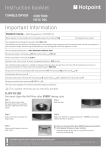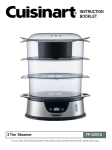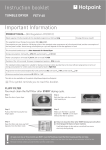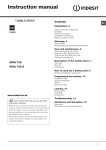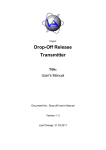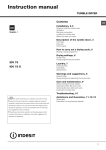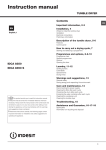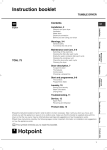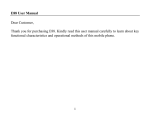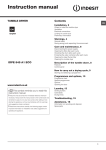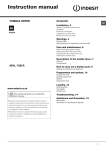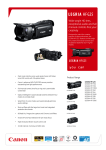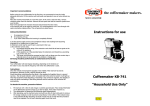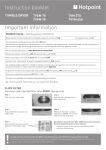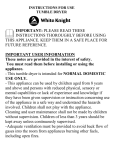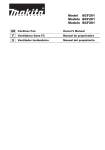Download User Manual
Transcript
Instruction booklet TUMBLE DRYER IDC 85 (UK) IDC 85 S (UK) IDC 85 K (UK) IDC 85 X (UK) This symbol reminds you to read this booklet WHERE TO INSTALL THE TUMBLE DRYER 10 mm Install the dryer far from gas ranges, stoves, radiators or hobs as flames may damage it. If the dryer is installed below a worktop, ensure there are 10 mm 15 mm 15 mm between the upper panel of the dryer and any objects above it and 15 mm between the sides of the machine and the walls or furniture units adjacent to it. This ensures adequate air circulation.The appliance must be installed with the rear surface placed against a wall. ! We do not recommend that the dryer is installed in a cupboard but the dryer must never be installed behind a lockable door, a sliding door or a door with a hinge on the opposite side to that of the dryer door. Priming the Water Collection System. When your dryer is new, the water container will not collect water until the system is primed. This will take 1 or 2 drying cycles. Once primed it will collect water during every drying cycle. WATER DRAINAGE CONNECTION 2 1 Less than 1m If the dryer is installed next to a drain the water can be plumbed into this drain. This does away with the need to empty the water container. The height of the drain must be less than 1m from the bottom of the dryer. Remove the existing hose from the dryer and connect it to the drain (if required add an additional length of hose). ELECTRICAL CONNECTIONS The socket must be grounded. ! The power cord must be regularly checked. If the supply cord is damaged it must be replaced by the manufacturer, its service agent or similarly qualified persons in order to avoid a hazard. BEFORE YOU START USING YOUR DRYER Once you have installed your dryer and before you use it clean the inside of the drum to remove any dust that could have accumulated during transport. CONDENSER UNIT You MUST clean the fluff from the condenser EVERY month. Failure to clean the condenser could cause premature failure of your dryer. Remove the condenser unit regularly (at least monthly) and clean off any fluff deposits. Step 1 Open the condenser cover. Step 2 Remove the condenser by turning the 3 catches and pulling the condenser towards you. It is normal for some residual water to be left in the condenser unit. Step 3 Flush the condenser from the rear with water to remove any fluff deposits. Step 4 Replace the condenser unit and make sure that all 3 catches are closed and that the position arrows on the front of the condenser are pointing upwards. FLUFF FILTER You must clean the fluff filter after EVERY drying cycle. Step 1 Open the door of your dryer. Step 2 Pull out the filter (using the two finger grips). Step 3 Clean the fluff off the filter and replace it correctly. Step 4 Make sure the filter is pushed fully home NEVER run the dryer without the filter in position. Failure to clean the filter after EVERY drying cycle will affect the drying performance of your machine. It will take longer to dry and as a result will use more electricity during drying. WATER CONTAINER You MUST empty the water container after EVERY drying cycle. Removing the water container: Step 1 Pull the water container towards you and remove it completely from the dryer. Step 2 Empty all the water in the water container. Step 3 Replace the water container making sure that it is securely fixed. ! Failure to empty the water container will cause the machine to stop heating and the load may still be wet at the end of the drying cycle. The ‘Empty Water’ light will tell you that the water container needs to be emptied 2 Warnings ! This appliance has been designed and built according to international safety standards. These warnings are given for safety reasons and must be followed carefully. General safety This appliance can be used by children aged from 8 years and above and persons with reduced physical, sensory or mental capabilities or lack of experience and knowledge if they have been given supervision or instruction concerning use of the appliance in a safe way and understand the hazards involved. This tumble dryer has been designed for home and not professional, use. Do not touch the appliance while barefoot or with wet hands or feet. Unplug the machine by pulling on the plug, not the cord. After using the dryer, turn it off and unplug it. Keep the door closed to make sure that children do not use it as a toy. Children should be supervised to ensure that they do not play with the dryer. Cleaning and user maintenance shall not be made by children without supervision. Children of less than 3 years should be kept away from the appliance unless continuously supervised. The appliance must be installed correctly and have proper ventilation. The air intake at the front of the dryer should never be obstructed Never use the dryer on carpeting where the pile height would prevent air from entering the dryer from the base. Check to see if the dryer is empty before loading it. The back of the dryer could become very hot. Never touch it while in use. Do not use the dryer unless the filter, watercontainer and condenser are securely in place Do not overload the dryer (see Laundry for maximum loads). Do not load items that are dripping wet. Carefully check all instructions on clothing labels Do not tumble dry large, very bulky items. Do not tumble dry acrylic fibres at high temperatures. Do not turn off the dryer when there are still warm items inside. Clean the filter after each use. Empty the water container after each use. Clean the condenser unit at regular intervals . Do not allow lint to collect around the dryer. Never climb on top of the dryer. It could result in damage. Always follow electrical standards and requirements. Always buy original spare parts and accessories. To minimise the risk of fire in your tumble dryer, the following should be observed: Tumble dry items only if they have been washed with detergent and water, rinsed and been through the spin cycle. It is a fire hazard to dry items that HAVE NOT been washed with water. Do not dry garments that have been treated with chemical products. Do not tumble dry items that have been spotted or soaked with vegetable or cooking oils, this constitutes a fire hazard. Oil-affected items can ignite spontaneously,especially when exposed to heat sources such as a tumble dryer. The items become warm, causing an oxidisation reaction with the oil, Oxidisation creates heat. If the heat cannot escape, items can become hot enough to catch fire. Piling, stacking or storing oil-effected items can prevent heat from escaping and so create a fire hazard.If it is unavoidable that fabrics containing vegetable or cooking oil or those that have been contaminated with hair care products be placed in a tumble dryer they should first be washed with extra detergent - this will reduce, but not eliminate the hazard. They should not be removed from the dryer and piled or stacked while hot. Do not tumble dry items that have previously been cleaned in or washed in, soaked in or soiled with petrol/gasoline, dry cleaning solvents or other flammable or explosive substances. Highly flammable substances commonly used in domestic environments including cooking oil, acetone, denatured alcohol, kerosene, spot removers, turpentine, waxes and wax removers. Ensure these items have been washed in hot water with an extra amount of detergent before being dried in the tumble dryer. Do not tumble dry items containing foam rubber (also known as latex foam), or similarly textured rubber like materials. Foam rubber materials can, when heated, produce fire by spontaneous combustion. Fabric softener or similar products should not be used in a tumble dryer to eliminate the effects of static electricity unless the practice is specifically recommended by the manufacturer of the fabric softener product. Do not tumble dry undergarments that contain metal reinforcements eg. bras with metal reinforcing wires. Damage to the tumble dryer can result if the metal reinforcements come loose during drying. Do not tumble dry rubber, plastic articles such as shower caps or babies waterproof covers, polythene or paper. Do not tumble dry rubber backed articles, clothes fitted with foam rubber pads, pillows, galoshes and rubber coated tennis shoes. Remove all objects from pockets such as lighters and matches. WARNING: Never stop the dryer before the end of the drying cycle unless all items are quickly removed and spread out so that the heat is dissipated. Dryer Description Control panel The HEAT button selects drying temperature. OUT: LOW heat IN: HIGH heat High Heat button Start button Drying time selector knob The TIMER knob sets the drying time: rotate it clockwise, NEVER COUNTER-CLOCKWISE, until the indictor is pointing to the drying time you want to select. The Empty Water indicator light signals that the water container is full and must be emptied. The light will take a few seconds to go out after replacing the empty water container, the dryer must be running for this to happen. Note: If the water container fills up the indicator lights, the heat is WASH CARE LABELS Look at the labels on your garments when tumble drying. The following symbols are the most common. May be tumble dried Do NOT tumble dry turned off and your laundry will not dry. CHOOSING A PROGRAMME Tumble dry at high heat setting Standard Cotton - High (full) Heat Tumble dry at low heat setting Drying times 800-1000rpm spin in washing machine 1kg 2kg 3kg 4kg 30-40mins 40-55mins 55-70mins 70-80mins 5kg 6kg 7kg 8kg 80-90mins 95-120mins 120-140mins 130-150mins ITEMS NOT SUITABLE FOR TUMBLE DRYING 1. Articles that contain rubber or rubber-like materials or plastic film, any flammable articles or objects that contain flammable substances. 2. Glass fibres. Synthetics - Low (gentle) Heat 3. Items which have been dry cleaned. Drying times on reduced spin in washing machine 4. Large bulky items (quilts, sleeping bags, etc). These expand when drying and prevent airflow through the dryer. 1kg 2kg 3kg 40-50mins 50-70mins 70-90mins 1. Plug the dryer into the electrical socket. 2. Sort your laundry according to fabric type. 3. Open the door and make sure the filter is clean and in place. 4. Load the machine and make sure items are not in the way of the door seal. Close door. 5. Set the temperature with the HEAT button. High heat for Cotton. Low heat for delicates, synthetics and acrylics. 6. Select a drying time by rotating the TIMER knob clockwise. The tables below show APPROXIMATE drying times in minutes. Weights refer to dry garment weights. 7. Press the START button to begin. During the drying programme, you can check on your laundry and take out items that are dry while others continue drying. When you close the door again press the START button in order to resume drying. Troubleshooting Before you call the service centre go through the following troubleshooting suggestions: PROBLEM: The dryer won’t start. POSSIBLE CAUSES/SOLUTION: • The plug is not in the socket or making contact. • There has been a power failure. • The fuse has blown. Try to plug another appliance into the socket. • You are using an extension cord? Try to plug the dryer directly into the socket. • The timer knob has not been set properly. • The start button has not been pressed. 8. About 10 minutes before the programme is completed it enters the final COOL TUMBLE phase (fabrics are cooled) which should always be allowed to complete. • The door is not closed securely. 9. Open the door and take the laundry out. Clean and replace the filter. Empty and replace the water container. It is taking a long time to dry. 10. Unplug the dryer. PROBLEM: POSSIBLE CAUSES/SOLUTION: • The filter has not been cleaned. • The water container needs emptying? The empty water light is on? • The condenser needs cleaning. • The temperature setting is not correct. Laundry MAX LOAD SIZE Natural fibres: 8kg max Synthetic fibre: 3kg max • The correct time has not been selected. • The air intake grill is obstructed. • The items were too wet. • The dryer was over loaded. DISPOSAL OF OLD ELECTRICAL APPLIANCES The European Directive 2012/19/EC on Waste Electrical and Electronic Equipment (WEEE) requires that old household electrical appliances must not be disposed of in the normal unsorted municipal waste stream. Old appliances must be collected separately in order to optimise the recovery and recycling of the materials they contain and reduce the impact on human health and the environment. The crossed out “wheeled bin” symbol on the product reminds you of your obligation that when you dispose of the appliance it must be separately collected. Consumers should contact their local authority or retailer for information concerning the correct disposal of their old appliance. This appliance conforms to the following EC Directives: - 2006/95/EC (Low Voltage Equipment) - 2004/108/EC (Electromagnetic Compatibility) Indesit Company Spa Viale Aristide Merloni 47 60044 Fabriano (AN) Italy www.indesit.com Product Data - Regulation 392/2012. Brand Indesit Model IDC 85 (UK)- IDC 85 S (UK)- IDC 85 K (UK)- IDC 85 X (UK) Rated capacity of cotton laundry for the "standard cotton programme" at full load - kg 8.0 This household tumble drier is a Energy efficiency class on a scale from A+++ (low consumption) to D (high consumption) Condenser The weighted Annual Energy Consumption (AEc)* kWh 1) This household tumble drier is a Energy consumption full load; Edry - kWh 2) Energy consumption partial load; Edry½ - kWh 2) Power consumption: off-mode (Po) - Watts Power consumption: left-on mode (Pl) - Watts Duration of the 'left-on mode' for power management system minutes 627.2 Non-automatic 5.38 2.83 0.00 N/A C N/A Prog. Time - weighted (Tt) full & partial load - minutes 3) Full load (Tdry) - minutes Partial load (Tdry½) - minutes Condensation efficiency class on a scale from G (least efficient) to A (most efficient) Average condensation efficiency - % 80 154 112 weighted (Ct) full & partial load 3) full load (Cdry) partial load (Cdry½) Airborne acoustical noise emissions - dB(A) re 1 pW 71 72 71 69.0 C 1) The "standard cotton” at full and partial load are the standard programmes to which the information in the label and the fiche relates. The standard cotton program is suitable to dry at cupboard level (0%) cotton laundry and is the most efficient programme in terms of energy consumption. Partial load is half the rated load. 2) based on 160 drying cycles of the standard cotton programme at full and partial load, and the consumption of the low-power modes. Actual energy consumption will depend on how the appliance is used. 3) Weighted average of 3 cycles at full load and 4 cycles at half load. Regulation 932/2012. Energy consumption in kWh, for program “Synthetics” full load Programme time in minute, for program “Synthetics” full load 1.55 80 04/2014 Xerox Fabriano INFORMATION ON RECYCLING AND DISPOSAL As part of our continual commitment towards environmental protection, we reserve the right to use recycled quality components to reduce costs for our customers and to minimise materials wastage. • Disposing of the packaging materials: follow local regulations to allow for recycling of packaging materials. • In order to minimise the risk of injury to children, remove the door and plug, then cut the power supply cord flush with the appliance. Dispose of these parts separately to prevent the appliance from being connected to a power supply socket. SAVE ENERGY AND RESPECT THE ENVIRONMENT Wring out all items to eliminate excess water before tumble drying (if you use a washing machine first, select a high spin cycle). Doing this will save time and energy during drying. Always dry full loads - you save energy: single items or small loads take longer to dry. Clean the filter after each use to contain energy consumption costs OUR ADVISORS WILL REQUIRE THE FOLLOWING INFORMATION: • • • • name, address and postal code telephone number type of malfunction date of purchase • • • model number serial number This information can be found on the data plate located behind the door. Partial load for program “Synthetics” N/A Essential Contact Information INDESIT SERVICE - Service You Can Rely On At Indesit we pride ourselves on offering our customers the best service we possibly can, wherever you are in the UK and Ireland. Rest assured though, no one knows an Indesit appliance better than we do and our service is second to none… Wherever you are we can be there – we have over 1,000 highly skilled Indesit engineers covering the whole of the UK and Ireland ensuring fast, reliable, local service. ‘Right first time’ – our engineers have the latest tools to help get your Indesit appliance back up and running the first time we visit. Experts in our field – all of our engineers are trained to the highest standard at our Training Centre of Excellence and possess unrivalled expertise and product knowledge. Skilled staff – we have over 400 skilled UK based call centre staff, dedicated to offering you excellent service 364 days a year. Telephone in the United Kingdom: 08448 224 224 Telephone in the Republic of Ireland: 0818 313 413




